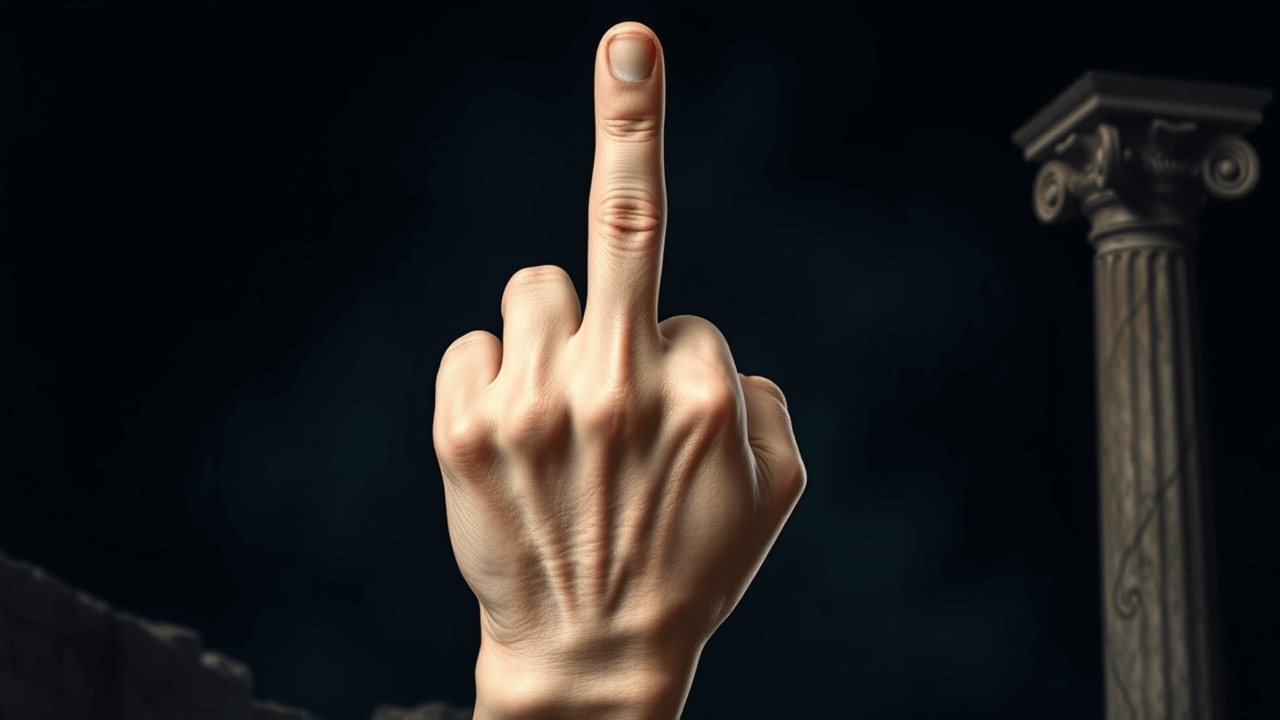Why Is the Middle Finger Such an Offensive Gesture?
Have you ever wondered why the middle finger is considered such a rude gesture? It’s something we see almost everywhere, from movies to real-life confrontations, but few people know the full story behind it. Let’s take a deep dive into the history of the middle finger and why this simple gesture carries so much weight.
Where Did the Middle Finger Gesture Come From?
To understand where the middle finger comes from, we need to go way back in time—all the way to Ancient Greece. Believe it or not, the middle finger was used even back then, and just like today, it wasn’t exactly a gesture of goodwill. In fact, it was a pretty graphic symbol.
Back in ancient Greece, the middle finger was used as a phallic symbol. The gesture represented a certain part of male anatomy, with the middle finger being the “shaft” and the curled fingers representing, well, let’s say the rest. It wasn’t just about making a crude joke; it was also about power and dominance.
Capigan: The Word Behind the Gesture
What’s fascinating is that the Greeks even had a word for this gesture—“capigan.” Not only did it refer to the gesture itself, but it was also used to describe a submissive male. So, the middle finger wasn’t just a symbol of anatomy; it had deeper social implications. It was a way of putting someone in their place, asserting dominance or control.
The Myth of the English Archers
Many people have heard the story of English archers flipping off the French during medieval times, supposedly to show they could still use their bows despite the threat of having their middle fingers cut off. It’s a great story, but unfortunately, there’s little evidence to back it up. In fact, sites like Snopes have debunked this myth thoroughly. While the tale is fun to tell, it’s not based in historical fact.
Why Does the Middle Finger Still Hold So Much Power?
Even though the origins of the middle finger are ancient, the gesture still packs a punch today. Why is that? Well, it taps into something primal. If someone flips you off, even if you don’t know the history, it feels instinctively wrong, right? There’s an instant sense that things have escalated.
This is because gestures are about more than just what they represent—they’re about the intent behind them. The middle finger conveys emotions like anger, frustration, defiance, and sometimes even contempt without saying a word. That’s what makes it so universally recognized and powerful. It’s a nonverbal way to say, “Back off.”
Cultural Differences: Not All Gestures Mean the Same Thing Everywhere
While the middle finger is offensive in many cultures, what we consider rude can vary a lot around the world. For example, in some cultures, using your left hand for tasks like eating or greeting is considered very disrespectful. It’s amazing how such seemingly small actions can carry such different meanings depending on where you are.
It all comes down to cultural norms. What’s considered polite or rude can shift based on where you live and how your society has developed. So, while the middle finger might be universally understood in some places, other gestures could have entirely different interpretations in different parts of the world.
Why Has the Middle Finger Stuck Around for So Long?
One reason the middle finger has lasted for centuries is its taboo nature. From a young age, we’re taught that it’s a bad gesture. That forbidden quality gives it power. Using it feels like a small act of rebellion—like breaking a rule. And in moments of anger or frustration, that rebellious edge makes it all the more satisfying.
Another reason it’s so enduring is because it’s incredibly simple and effective. It’s like the ultimate “nope” button. When words fail, the middle finger speaks volumes, and everyone, no matter their language, knows what it means.
Could Other Gestures Become Offensive in the Future?
One of our listeners posed an interesting question: Could something harmless today become the next middle finger in the future? It’s possible! Gestures, like language, are constantly evolving. Something innocent today could take on a new, offensive meaning tomorrow. With the speed of social media, even emojis have started to develop new interpretations.
This constant evolution of communication—whether through gestures, memes, or symbols—is fascinating. We might someday be talking about the thumbs-up emoji in the same way we talk about the middle finger today.
FAQ Section
Where did the middle finger gesture originate?
The middle finger gesture originated in Ancient Greece. It was used as a phallic symbol, representing male anatomy, and was also tied to social meanings of power and dominance.
Is the story about English archers flipping off the French true?
No, the story about English archers using the middle finger against the French is a myth. There’s no historical evidence to support this tale.
Why is the middle finger considered offensive?
The middle finger is offensive because it’s a nonverbal way to express anger, defiance, or contempt. Its ancient origins and the intent behind it give it its strong, negative connotation.
Do other cultures have different offensive gestures?
Yes, different cultures have their own gestures that are considered rude. For example, in some places, using your left hand for eating or greeting is viewed as very disrespectful.
Can gestures change meaning over time?
Yes, the meaning of gestures can evolve over time. What’s considered harmless today might become offensive in the future, especially with how fast language and communication change in the digital age.
Your Hosts

Alex & Maria
Join Alex Thompson and Maria Davis as they navigate the fascinating world of knowledge. With their combined expertise and passion for learning, they simplify the complex and make every episode a journey worth taking.

